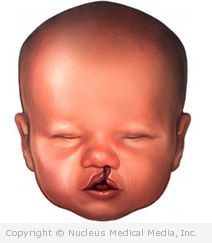(Oral-Facial Clefts; Cleft Palate)
Cleft lip – Definition
An oral-facial cleft is a birth defect. It occurs when the lip or the roof of the mouth do not form properly. The defect may include a cleft lip, a cleft palate or both. A cleft lip is a gap in the upper lip. It is usually just below the nose. A cleft palate is a gap in the roof of the mouth or in the soft tissue at the back of the mouth. In the majority of cases, a cleft lip and cleft palate may both occur.
Cleft lip – Causes
Early in pregnancy all babies have an opening in the lip and palate. As the baby grows these openings should gradually grow together. By birth, the openings should be closed. For some reason, in children with oral-facial clefts, these openings fail to close. The exact reason these openings don’t close is not known.
Cleft lip – Risk Factors
Factors in the infant that may increase the risk for oral-facial clefts include:
- Having other birth defects
- Sex: males
- Having a sibling, parent, or other close relative born with an oral-facial cleft
- A geneticist can best define the actual risk, which can vary greatly among families.
- In general, if one child in a family has a cleft palate, the next child has about a 4% chance of also having a cleft palate. If only the lip has a cleft, the risk of this occurring in a second child is about 2%.
Factors in the mother during pregnancy that may increase the risk for oral-facial clefts:
- Taking certain drugs, such as antiseizure drugs (especially phenytoin), thalidomide, or retinoic acid (used for dermatologic conditions, such as acne)
- Smoking
- Consuming alcohol (especially in the development of a cleft lip)
- Having diabetes
Cleft lip – Symptoms
The major symptom of a cleft lip and/or cleft palate is a visible opening in the lip or palate.
Complications that can occur as a result of an oral-facial cleft include:
- Feeding problems, especially with cleft palate
- Problems with speech development
- Dental problems, including missing teeth, especially when cleft lip extends to the upper gum area
- Recurrent middle ear infections
- Hearing problems
Cleft lip – Diagnosis
A doctor can diagnose cleft lip or cleft palate by examining the newborn baby. A newborn with an oral-facial cleft may be referred to a team of medical specialists soon after birth. Rarely, a mild cleft palate may not be diagnosed for several months or even years.
Cleft lip and palate are sometimes associated with other medical conditions. Your doctor should be able to tell you whether or not your child’s cleft is as sign of a larger condition. Some of these conditions may need additional treatment.
Your doctor may be able to see a cleft lip before birth. It may be seen during an ultrasound examination. A cleft lip can be seen as early as 18 weeks of pregnancy. Cleft palate may be harder to see before birth because they are inside the mouth. Treatment can not be started until after birth. However, diagnosis during pregnancy will give the parents and the medical team time to prepare a care plan.
Cleft lip – Treatment
Surgery is the main treatment. The primary goal of surgery is to close the gap in the lip and palate. Other surgery may also be needed for:
- Bite alignment surgery if the jaw is not aligned properly
- Plastic and/or nasal surgery to improve facial appearance and function
A cleft defect can make it difficult for your child to eat or drink. Your child may be given a dental plate. It is placed in the roof of the mouth. It should make it easier to eat and drink until surgery can be done.
Cleft palates may also be associated with ear and hearing problems. If your child has a middle ear infection or fluid build-up your doctor may recommend:
- Medications to treat infection or prevent fluid build-up
- Surgery to drain built-up fluid and prevent future infections
Hearing testing should be done regularly. Rarely, children with cleft palate may benefit from hearing aids.
Cleft lip – Prevention
Pregnant women and women who are likely to become pregnant can do the following to help prevent oral-facial clefts in their unborn children:
- Consume 400 micrograms of folic acid every day. Folic acid intake may include a daily multivitamin and eating foods containing folic acid, such as:
- Fruits and orange juice
- Green leafy vegetables
- Dried beans and peas
- Pasta, rice, bread, flour, and cereals
- Do not smoke or drink alcohol during pregnancy.
- Talk to your doctor about any medications during pregnancy. Only use them as directed by your doctor.
- Get early and regular prenatal care.
- If you are thinking about having a child and have risk factors for oral-facial cleft:
- Seek medical advice on additional ways to prevent the disorder.
- Consider genetic counseling.

